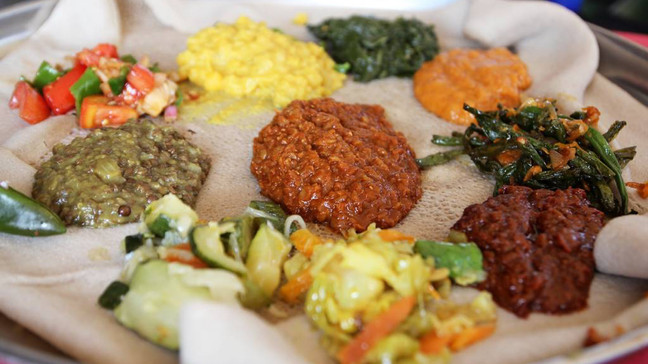nightglow.info – Injera, a spongy, slightly tangy flatbread, is the cornerstone of Ethiopian and Eritrean cuisine. Made from teff, an ancient and nutritious grain native to the region, injera serves as both the plate and the utensil in traditional meals. Its unique texture and flavor profile, combined with its cultural significance, make it an indispensable part of the culinary landscape of the Horn of Africa.
Origins and Cultural Significance
The origins of injera are deeply intertwined with the cultivation of teff, a tiny but resilient grain that thrives in the Ethiopian and Eritrean highlands. Teff has been cultivated in the region for thousands of years, and injera has evolved alongside it as a staple food.
Injera holds significant cultural importance in Ethiopian and Eritrean societies. It is more than just food; it is a symbol of hospitality, community, and shared meals. Meals are typically served on a large, round injera placed on a mesob (a woven table), with various stews, salads, and other dishes arranged on top. Diners use pieces of injera to scoop up the food, eliminating the need for utensils. This communal style of eating fosters a sense of togetherness and strengthens social bonds. Injera also plays a role in various cultural ceremonies and celebrations, further cementing its cultural significance.
Preparing Injera: A Fermentation Process
The preparation of injera is a multi-step process that involves fermentation, giving it its characteristic tangy flavor and spongy texture.
-
Mixing the Dough: Teff flour is mixed with water to create a batter. The consistency of the batter is crucial; it should be thin enough to pour easily but thick enough to hold its shape slightly.
-
Fermentation: The batter is left to ferment for several days, typically two to three days, depending on the ambient temperature. During this time, naturally occurring yeasts and bacteria in the teff flour cause the batter to ferment, producing lactic acid and carbon dioxide. This fermentation process is what gives injera its distinctive sour taste and creates the characteristic bubbles that give it its spongy texture. A starter, called ersho, from a previous batch of injera is often used to kickstart the fermentation process.
-
Baking the Injera: Once the batter has fermented, it is poured onto a large, circular clay or metal griddle called a mitad. The mitad is heated to a high temperature, and the batter is poured in a circular motion to create a thin, even layer. The injera cooks quickly, developing small holes on the surface as the carbon dioxide bubbles escape. The injera is cooked until the top is set and the bottom is lightly browned.
-
Cooling and Stacking: The cooked injera is carefully removed from the mitad and allowed to cool. Multiple injeras are then stacked on top of each other, ready to be served.
Serving and Accompaniments
Injera serves as both the plate and the utensil in Ethiopian and Eritrean meals. Various stews, known as wats, and other dishes are placed on top of the injera. Diners tear off pieces of injera and use them to scoop up the food.
Some common accompaniments to injera include:
- Wat (Stew): A rich and flavorful stew made with various ingredients, such as meat (chicken, beef, lamb), vegetables, and spices. Common wats include doro wat (chicken stew), siga wat (beef stew), and misir wat (lentil stew).
- Tibs (Sautéed Meat): Sautéed meat, often cooked with onions, peppers, and spices.
- Vegetable Dishes: Various vegetable dishes, such as shiro (chickpea stew), atakilt wat (mixed vegetable stew), and gomen (collard greens).
- Salads: Fresh salads, often made with tomatoes, onions, and peppers.
Nutritional Value and Health Benefits
Injera, made from teff, offers several nutritional benefits. Teff is a good source of:
- Fiber: Teff is high in fiber, which aids digestion and promotes gut health.
- Iron: Teff is a good source of iron, which is essential for oxygen transport in the blood.
- Protein: Teff contains a good amount of protein, making it a valuable source of nutrition, especially for vegetarians and vegans.
- Calcium: Teff is also a source of calcium, which is important for bone health.
- Gluten-Free: Teff is naturally gluten-free, making injera a suitable option for people with celiac disease or gluten sensitivity.
Regional Variations
While the basic concept of injera remains the same across Ethiopia and Eritrea, there are some regional variations in the type of teff used, the fermentation process, and the specific dishes served with it.
Injera’s Enduring Legacy
Injera’s enduring presence in Ethiopian and Eritrean cuisine speaks to its versatility, nutritional value, and cultural significance. It is more than just a food; it is a symbol of hospitality, community, and the rich cultural heritage of the Horn of Africa. As Ethiopian and Eritrean cuisine gains international recognition, injera continues to be a central element, introducing people around the world to the unique flavors and traditions of this fascinating region.
